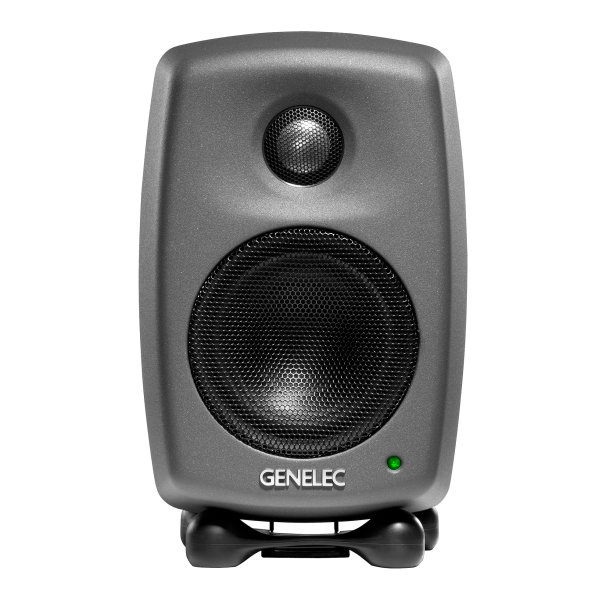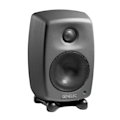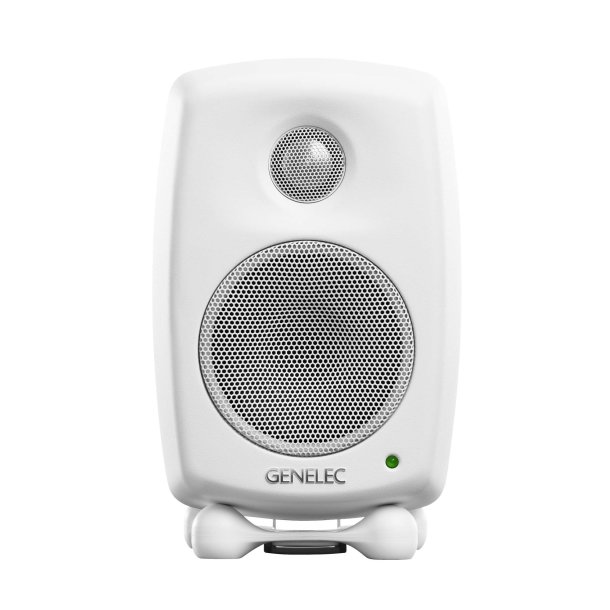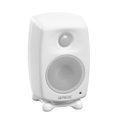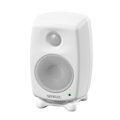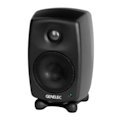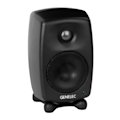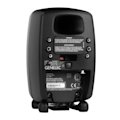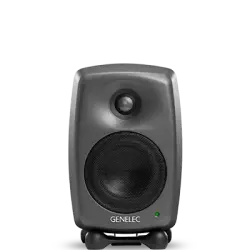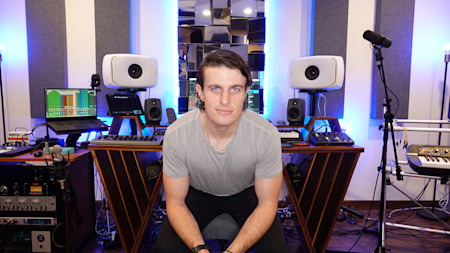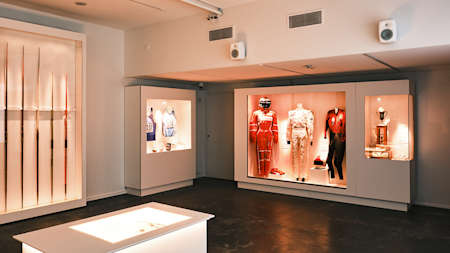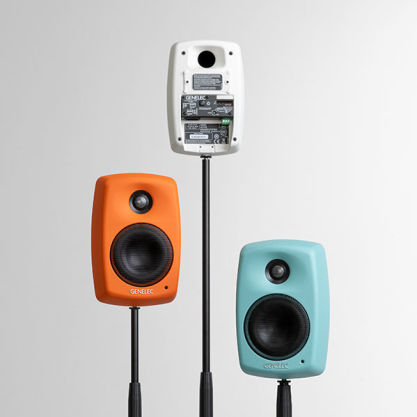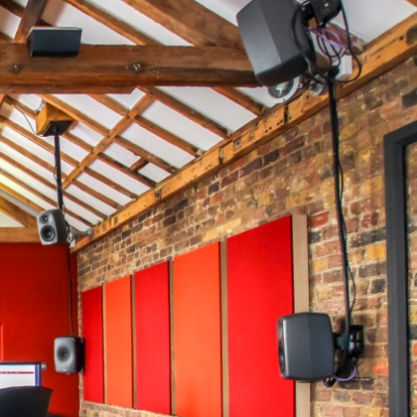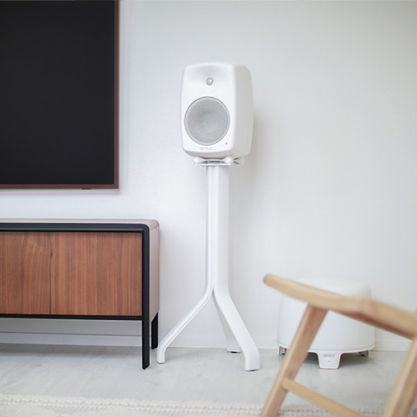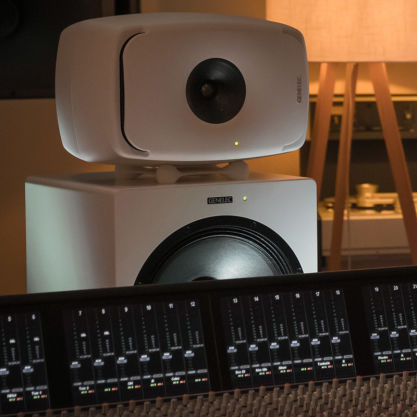8010A kombinerar utomordentlig referensåtergivning och utökad frekvensgång i ett otroligt kompakt format.
8010A
Studio Monitor

Aktiva delningsfilter

Rumskorrigering

SPL
96 dB

Frekvensomfång
67 Hz - 25 kHz (-6 dB)

Mått
H 195 x W 121 x D 115 mm, med Iso-Pod™ (vy i tum)

Liten i storlek, enorm i prestanda.
När studion är liten alternativt att inspelning sker på annan plats, är 8010A din tillförlitliga monitor-partner. Låt dig inte luras av vare sig det tilltalande priset eller dess modesta dimension, 8010A är i varje liten del en fullvärdig professionell monitor: ofärgad, exakt och kraftfull.
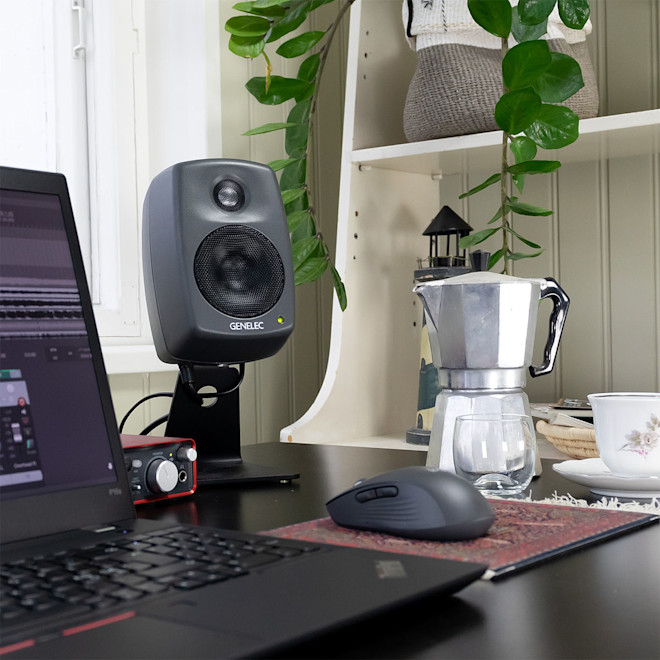
Förtroende är allt
Kombinationen kabinett, högtalarelement och det elektroniska utförandet resulterar i 8010A´s extremt neutrala återgivning och förmåga att anpassa sig till lyssningsrummet med hjälp av enkla switchar på högtalarens baksida. Så vare sig du är i en enkel hemmastudio, på ett hotellrum eller i en OB buss kan du alltid lita på det du hör.
8010A
Awards

Genelec hit 2014 with the smallest monitors we have tested all year, but you wouldn’t know it to listen to them.
They offer impressive low-frequency response, a smooth accurate high-end and well-balanced mids - what’s not to like?
The 8010As measure just under 20cm high and, as with all Genelecs, the build quality is second to none. Even though housed in die-cast aluminium, they are still quite light at 1.5kg each.
4.5 out of 5

"A sound choice we feel, the unbelievably accurate Genelec 8010A’s are our platinum award winners."

Genelec 8010A Studio Monitor was awarded a TEC Award 2015 in the category of Studio Monitor Technology.
Source https://www.namm.org/thenammshow/2015/articles/30th-annual-namm-tec-award-winners-announced
Tekniska Specifikationer

SPL
96 dB

Förstärkareffekt
25 W Bass (Class D) + 25 W Treble (Class D)

Frekvensomfång
67 Hz - 25 kHz ("-6 dB")

Noggrannhet Frekvensomfång
± 2.5 dB (74 Hz - 20 kHz)

Storlek på högtalarelement
⌀ 76 mm Bass + ⌀ 19 mm Treble (vy i tum)

Mått
H 195 x W 121 x D 115 mm, med Iso-Pod™ (vy i tum)

Vikt
1.5 kg / 3.3 lb

Anslutningar
1 x XLR Analog Input
8010A Studio Monitor
Studio Monitor
Tekniska Specifikationer
8010A kombinerar utomordentlig referensåtergivning och utökad frekvensgång i ett otroligt kompakt format.

Specifikationer för system
Frekvensomfång
74 Hz - 20 kHz (± 2.5 dB)
Low cutoff -6 dB
67 Hz
High cutoff -6 dB
25 kHz
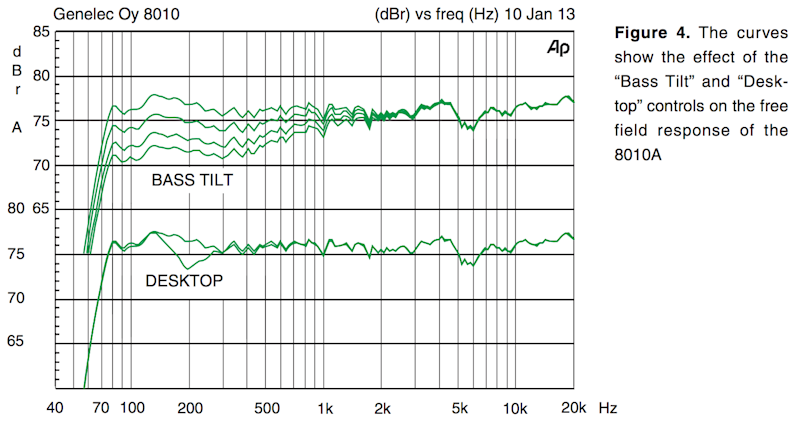
SPL
Peak SPL Maximum peak acoustic output per pair on top of console, at 1 m distance with music material.
≥105 dB
Short term max SPL Max. short term sine wave acoustic output on axis in half space, averaged from 100 Hz to 3 kHz, at 1m distance.
≥96 dB
Long term max SPL Maximum long term RMS acoustic output in same conditions with IEC weighted noise (limited by driver unit protection circuit) @ 1m.
≥91 dB
Egenljud
Egenljud Self generated noise level in free field at 1m on axis (A-weighted)
≤5 dB SPL
Vikt
Vikt1.5 kg (3.3 lb)
Mått
Höjd
181 mm
Höjd med Iso-Pod
195 mm
Bredd
121 mm
Djup
115 mm
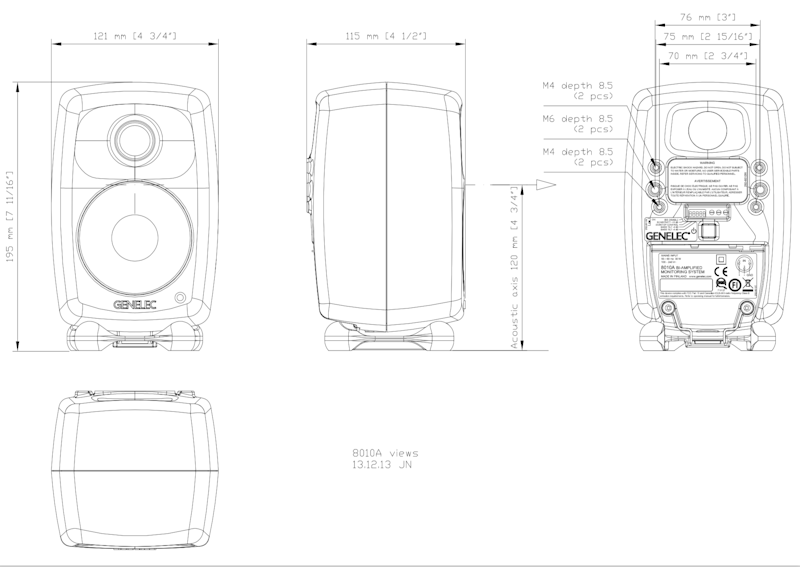
Kabinett
Material för kabinett
Die cast aluminium
Typ av kabinett
Reflex port
Högtalarelement
Typ av element
Cone
Diameter
76 mm
Typ av element
Metal dome
Diameter
19 mm
Direktivitet
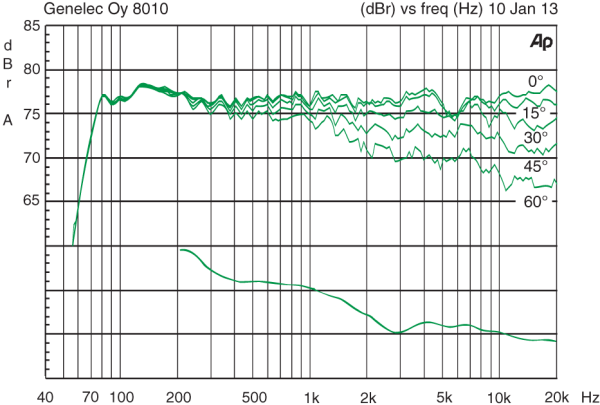
Harmonisk distorsion
> 400 Hz ≤0.5 %
Avsnitt Förstärkare
Förstärkare
25 W Class D
25 W Class D
Nätspänning
100-240 VAC 50/60Hz
Strömförbrukning
ISS Aktiverat
≤0.5 W
Inaktiv
≤5 W
Full effekt
30 W
Avsnitt Signalbehandling
Anslutningar
Input XLR female, 7 kOhm.
Delningsfilter
Bass/Treble
3000 Hz
Produktvarianter
Produktkoder
Passande Tillbehör
Produktkoder
För mer ingående teknisk information vänligen se produktens bruksanvisning
Nyckelteknologier

Aktiva delningsfilter

Rumskorrigering

Tekniken Directivity Control Waveguide (DCW™)

Intelligent Signal Sensing (ISS™)

Iso-Pod™-stativ

Tekniken Minimum Diffraction Enclosure (MDE™)

Optimerade förstärkare

Skyddskretsar

Reflexportdesign

Mångsidiga monteringsalternativ
Aktiva delningsfilter vid låga signalnivåer.

Elektroniska delningsfilter gör det möjligt att dela upp ljudsignalen i separata frekvensband som kan dirigeras till enskilda slutsteg, vilka sedan kopplas till specifika givare som är optimerade för ett specifikt frekvensband.
Aktiva delningsfilter finns både i digitala och analoga varianter. Genelecs digitala aktiva delningsfilter har extra funktioner för signalbearbetning, såsom skydd av element, fördröjning och utjämning.
Genelecs analoga aktiva delningsfilter innehåller elektroniska komponenter som används vid låga signalnivåer som är lämpliga för ineffekten till slutstegen. Detta till skillnad från passiva delningsfilter som används vid höga signalnivåer från slutstegets uteffekt, vilket gör att de måste hantera höga strömstyrkor och i vissa fall även hög spänning.
I ett vanligt tvåvägssystem behöver de aktiva delningsfiltren två slutsteg – ett för baselementet och ett för diskantelementet.
Designen med aktiva delningsfilter har flera fördelar:
– Frekvensgången blir oberoende av eventuella dynamiska förändringar i elementets elektriska egenskaper eller nivå.
– Ökad flexibilitet och precision för att finjustera den utgående frekvensgången för de specifika elementen.
– Varje element har ett eget slutsteg och egen signalbearbetning. Detta isolerar varje element från de signaler som hanteras av övriga element, vilket minskar problemen med intermoduleringsdistorsion och förvrängning.
– Möjlighet att kompensera för känslighetsvariationer mellan elementen.
– Möjlighet att kompensera för avvikelser i frekvens- och fasåtergivning som är kopplade till elementets egenskaper inom det avsedda passbandet.
– Den platta frekvensgång som en högkvalitativ aktiv högtalare ger är resultatet av den kombinerande effekten av delningsfilterresponsen, slutstegsresponsen och elementresponsen i ett högtalarkabinett.
Genom att använda en aktiv teknik kan man justera frekvensgången och optimera hela högtalarsystemet i olika miljöer utan att behöva använda dyra externa equalizers. Slutresultatet är ett enklare, mer tillförlitligt, effektivt, konsekvent och precist aktivt högtalarsystem.
Precis rumskorrigering för optimering av högtalarprestandan i ditt rum.

Interaktionen mellan rummets akustik och högtalarens ljudspridning är komplex. Alla rum påverkar monitorhögtalarens återgivning på något sätt, till exempel reflekterande rum jämfört med ljudisolerade rum och placering av högtalarutrustning vid väggen eller på avstånd från väggen.
Alla högtalare från Genelec har rumskorrigeringsalternativ som kan användas för att kompensera för rummets påverkan på akustiken och uppnå en platt frekvensgång vid lyssningspositionen.
Analoga system
Genelecs analoga högtalare har mångsidiga rumskorrigeringsalternativ. Här ingår (beroende på modell):
– Lågfrekvensfilter och -lutning
– Diskantfilter och -lutning
– Basnivå
– Mellanregisternivå
– Diskantnivå
– Desktop Control

För lågfrekvenser finns två huvudsakliga styrningsalternativ. Baslutningskontrollen fungerar som ett shelving-filter tillsammans med lågfrekvensfiltret som gör det möjligt för dig att optimera systemets låga och riktigt låga frekvensgång i olika installationer. Styrningsalternativ för bas, mellanregister och diskant finns för de större systemen. Dessa styrningsalternativ gör det möjligt att optimera den relativa balansen mellan de olika passbanden.
Användarmanualen och databladet för varje högtalare innehåller en lista över de rekommenderade rumskorrigeringsinställningarna för olika installationer. De har tagits fram utifrån lång praktisk erfarenhet och mätningar av olika typer av vanliga akustiska miljöer.
Smart Active Monitor-system (SAM™)
Genelecs SAM-system erbjuder ett omfattande och lösningsinriktat produktsortiment med smarta anslutningsmöjligheter där alla produkter har programvaran Genelec Loudspeaker Manager (GLM™) och dess system för automatisk kalibrering, AutoCal™.
AutoCal från Genelec ger dig möjlighet att för första gången genomföra en integrerad process för fullständigt automatiserad mätning, analys och justering av alla monitorhögtalare i GLM-nätverket. Systemet mäter återgivningen i lyssningsområdet och tillämpar lämplig kompensering för lågfrekvenserna och låg- till mellanfrekvenserna för att minimera negativ akustisk påverkan från rummet samt skillnaderna mellan olika lyssningspositioner. AutoCal justerar även relativa nivåer, löptid och korrekt delningsfas (AutoPhase) för alla subwoofers i systemet.

Programmet Acoustic Response Editor visar den uppmätta återgivningen, filterkompenseringen och den resulterande systemåtergivningen för varje monitorhögtalare i diagram med full manuell kontroll över de akustiska inställningarna.
Tekniken Directivity Control Waveguide (DCW™) för platt återgivning både on-axis och off-axis.

1983 tog Genelec ett revolutionerande steg med utvecklingen av tekniken Directivity Control Waveguide (DCW™), som på den tiden användes i ett äggformat kabinett. Genelecs DCW-teknik har utvecklats och finjusterats i över 30 år och syftet är att förbättra prestandan för direktstrålande flervägsmonitorer betydligt.
DCW-tekniken formar den utgående vågfronten på ett kontrollerat sätt, vilket möjliggör förutsägbar anpassning av ljudets spridningsmönster. Målet är att begränsa spridningsvinkeln så att ströspridning minskas för att göra spridningen jämn och enhetlig. Det leder till en utomordentligt platt frekvensgång och en enhetlig kraftrespons. Den avancerade DCW-tekniken minimerar tidiga reflektioner och ger ett brett och stabilt lyssningsområde med korrekt ljudåtergivning både on-axis och off-axis.
Minimerade tidiga reflektioner och kontrollerad, konstant direktivitet har ytterligare en viktig fördel: frekvensbalansen i rummets efterklangsfält blir mer eller mindre likadan som det direkta ljudfältet från monitorhögtalarna. Detta leder till att monitorsystemets prestanda blir mindre beroende av rummets akustiska egenskaper.
Ljudbildens djup och bredd är viktiga aspekter i alla lyssningsmiljöer, och de är inte bara viktiga on-axis utan även off-axis. Detta hjälper inte bara ljudteknikern som gör jobbet, utan även andra som befinner sig i lyssningsområdet – och det är ofta många inblandade i större kontrollrum.
Huvudsakliga fördelar med DCW™-tekniken:
– Platt återgivning både on-axis och off-axis för ett större funktionellt lyssningsområde
– Ökat förhållande mellan direkt och reflekterat ljud för minskad färgning
– Förbättrad stereo- och ”soundstage”-ljudbild
– Ökad känslighet för drivenheterna på upp till 6 dB
– Ökad högsta ljudtryckskapacitet
– Minskad distorsion för drivenheterna
– Minskade kantdiffraktioner
– Övergripande minskad distorsion
Intelligent Signal Sensing (ISS™) minskar strömförbrukningen i standby-läge.

Intelligent Signal Sensing lanserades 2013 och uppfyller både EU:s ErP-direktiv och Genelecs egna hållbarhetsåtaganden.
ISS™-kretsen övervakar högtalarens signalingång och fastställer om den används eller inte. Om ISS-kretsen inte känner av någon ljudsignal under en viss tid försätter den automatiskt högtalaren i strömsparläge så att den drar mindre än 0,5 W. När en ingångssignal upptäcks aktiveras högtalaren direkt. Högtalaren kommer att börja spara ström direkt när arbetet pausas.
En ”ISS Disable”-brytare finns på baksidan av alla högtalare, bredvid rumskorrigeringsreglagen. När högtalarens huvudströmbrytare står på ”ON” aktiveras ISS™-funktionen (strömsparläge) automatiskt.

Om du inte vill använda ISS™-funktionen kan du stänga av den genom att sätta ”ISS Disable”-brytaren på den bakre panelen på ”ON”. I det här läget stängs högtalaren av och slås på endast med hjälp av huvudströmbrytaren.
Observera att man alltid kan stänga av högtalaren helt med huvudströmbrytaren.
Iso-Pod™-stativet separerar högtalaren från ytan för minimerade vibrationer och förbättrad ljudbild.

Även om det rekommenderas att använda stabila och robusta golvstativ till fristående högtalare är det vanligt att man placerar dem direkt på ett bord eller på mixerbordet.
Detta leder till flera ofördelaktiga effekter. Man glömmer ofta att rikta högtalaren mot lyssnaren, dessutom sprider sig oönskade mekaniska vibrationer från högtalaren till ytan och första ordningens reflektioner från ytan leder till kamfiltrering och därmed ojämnheter i frekvensgången.
För att lösa dessa vanliga problem har Genelec utvecklat en effektiv och praktisk lösning. Vi har designat högtalarstativet Iso-Pod™ – Isolation Positioner/Decoupler – som fästs på aluminiumkabinettet. Iso-Pod är gjort av ett särskilt flexibelt, gummiliknande material. Kabinettet står stabilt på stativet och kan flyttas längs den böjda ytan eller sidan för att luta högtalaren ±15°.
Högtalarens akustiska axel kan därmed riktas precist mot lyssnaren genom att man justerar kabinettets lutning med Iso-Pod-stativet. Isoleringen av vibrationer och de dämpande egenskaperna minskar mellanregisterfärgning orsakad av oönskade vibrationer som överförs till bärande ytor.
Den innovativa lösningen är en väsentlig del av Genelecs högtalardesign och ger massor av fördelar när det kommer till både användning av högtalaren och ljudkvaliteten.
Tekniken Minimum Diffraction Enclosure (MDE™) för ofärgad ljudåtergivning.

Ett vanligt problem med vanliga fristående högtalare är att ojämnheter i den främre baffeln leder till diffraktioner och att högtalarens skarpa kanter agerar som en sekundär källa för reflektionerna.
I syfte att förbättra frekvensgångens platthet och kraftresponsen från fristående högtalarsystem har Genelec designat innovativa kabinett med rundade kanter och lätt svängda linjer som är optimerade för att matcha högtalarelementens egenskaper. Förutom att leverera en utomordentligt platt frekvensgång ger dessa kabinett med minimal diffraktion en otroligt högpresterande ljudbild.
I syfte att få en elegant, välvd yta på kabinettet och för att minska dess yttermått, samtidigt som den interna volymen maximeras för bättre lågfrekvenseffekt, har vi designat ett kabinett av formgjutet aluminium. Aluminium är ett lättviktigt och stabilt material som är lätt att dämpa för att på så sätt få en mer resonansdöd konstruktion. Kabinettets väggar kan göras förhållandevis tunna, samtidigt som materialet ger bra EMC-skärmning och utgör ett utomordentligt kylelement för slutstegen. Formgjutningen görs i två delar, en främre och en bakre, för enkel separering vid eventuell service och reparation.
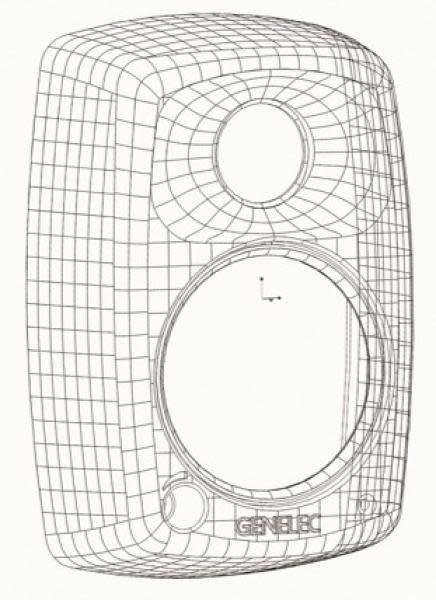
DCW-vågledaren är integrerad i MDE-kabinettet av aluminium för att ge bättre kontroll av högtalarens ljudspridning. Lågfrekvensgränsen för konstant direktivitet är beroende av vågledarens storlek, så ju större den är desto bättre kontroll ger den. Med en kontrollerad ljudspridning off-axis får man ett konsekvent lyssningsfönster, vilket är otroligt viktigt vid multikanallyssning. Kontrollerad ljudspridning minskar även första ordningens reflektioner från ytor i närheten av högtalaren, vilket bidrar till att ge konsekvent ljudåtergivning i varierande akustiska miljöer. Hela främre baffeln är lätt böjd och de akustiskt transparenta gallren är en del av det yttre kabinettets estetik, vilket gör att de smälter in väl med andra svängda ytor.

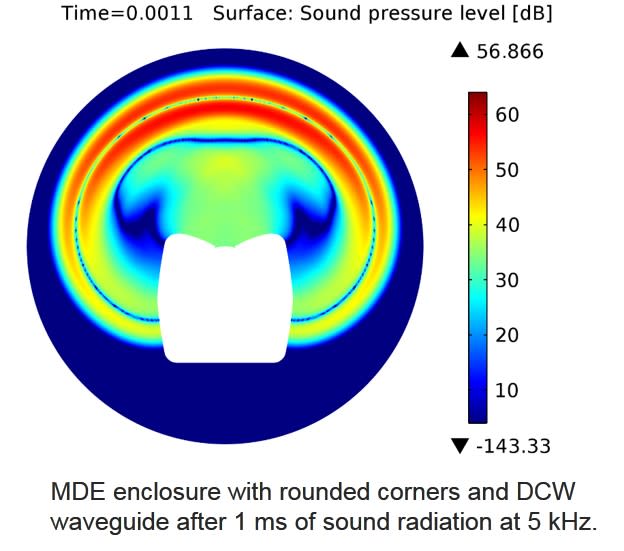
Varje givare drivs av en egen optimerad förstärkare.

Elektroniska delningsfilter gör det möjligt att dela upp ljudsignalen i separata frekvensband som kan dirigeras till enskilda slutsteg, vilka sedan kopplas till specifika givare som är optimerade för ett specifikt frekvensband.
I ett vanligt tvåvägssystem behöver det aktiva delningsfiltret två slutsteg – ett för baselementet och ett för diskantelementet. Slutstegen är direkt kopplade till den aktiva högtalarens element, vilket gör att slutstegens belastning blir mycket enklare och välkänd. Varje elementspecifikt slutsteg har endast en begränsad frekvens att förstärka (slutsteget är placerat efter det aktiva delningsfiltret), vilket bidrar till att göra designen enkel.
Den aktiva designprincipen har flera fördelar:
– Slutstegen är direkt kopplade till högtalarens element, vilket maximerar kontrollen som utövas av slutstegens dämpning på elementets talspole. Detta reducerar i sin tur följderna av dynamiska förändringar i elementets elektriska egenskaper. Detta kan förbättra systemets transienta svar.
– Minskning av den uteffekt som krävs från slutsteget. Tack vare att ingen energi går förlorad i komponenterna till det passiva delningsfiltret minskas den uteffekt som krävs från slutsteget betydligt (med upp till 50 % i vissa fall), utan någon minskning av den akustiska uteffekten i högtalarsystemet. Detta kan bidra till att sänka kostnader och öka både ljudkvaliteten och systemets tillförlitlighet.
– Ingen förlust mellan förstärkaren och elementenheterna, vilket leder till maximal akustisk effektivitet.
– Den aktiva tekniken kan uppnå överlägsen ljudprestanda vs. storlek vs. lägre frekvensgräns.
– Alla högtalare levereras som ett fabrikskonfigurerat system (förstärkare, delningsfilterkomponenter, kabinett och elementsystem).
Sofistikerade skyddskretsar för drivenheter för säker användning.

När du arbetar med avancerad ljudproduktion är det otroligt viktigt att dina monitorsystem alltid är tillförlitliga och fungerar som de ska. Det främsta skälet till Genelecs framgångar inom sändningstillämpningar är våra produkters tillförlitlighet, och en viktig faktor bakom detta är de interna skyddskretsarna som finns i alla våra produkter – ända sedan 1978.
Skyddskretsarna förebygger fel på elementet genom att analysera signalnivåerna. Vid plötsliga toppar eller för höga nivåer under en längre tid minskas signalnivån automatiskt. Den här funktionen påverkar givetvis inte ljudkvaliteten på något sätt när högtalaren används inom ramen för dess specifikationer. Den hindrar endast avvikande ingångssignaler från att orsaka skada på högtalaren.

Skyddskretsarnas funktioner och fördelar:
– Minskar uteffektnivån vid behov (t.ex. när temperaturen vid elementets talspole uppnår ett gränsvärde), vilket förbättrar systemets tillförlitlighet betydligt
– Lämpliga skyddskretsar i alla högtalare och subwoofers gör det möjligt att maximera systemets utgående ljudnivå.
Avancerad reflexportdesign för utökad lågfrekvensgång.
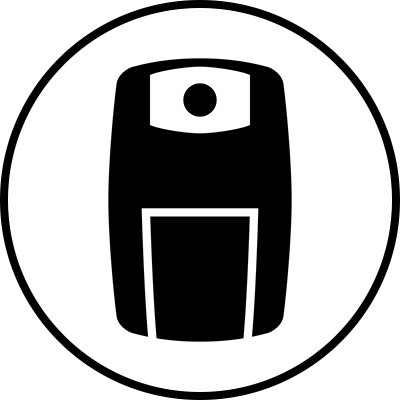
Genelecs design med ventilerade kabinett (reflexkabinett) går tillbaka till modellen S30, vår första produkt från 1978. Reflexportarnas prestanda har förbättrats och finjusterats genom åren med syftet att öka baselementets lågfrekvensdjup och ljudtryckskapacitet för att kunna ge en utomordentligt tydlig basåtergivning.
Både elementet och ventileringen bidrar till reflexkabinettets totala ljudspridning. Det mesta av ljudspridningen kommer från högtalarelementet, men vid reflexportens resonansfrekvens är elementets förflyttning så liten att det mesta av ljudspridningen kommer ut genom reflexporten.
För att minimera luftens hastighet genom röret bör tvärsnittsarean vara stor. Detta innebär att röret måste vara långt, vilket är en utmaning när det kommer till utformningen.
Det långa, böjda röret maximerar luftflödet så att en djup basgång kan återges utan kompression. Reflexröret slutar i en bred konisk öppning på baksidan av kabinettet, vilket minimerar missljud och ger en utomordentlig basåtergivning.
Rörets böjning har även utformats noggrant för att minimera missljud, kompression och distorsion. Den inre änden av röret har en korrekt resistiv avslutning som vidare minimerar det hörbara blåsljudet och luftturbulensen.
Korrekt utformade reflexportar gör det möjligt att minska baselementets förskjutning betydligt, vilket förbättrar den linjära lågfrekvenskapaciteten.
Mångsidiga monteringsalternativ för alla installationsbehov.

Förutom utomordentlig akustisk design och avancerade alternativ för optimering av högtalarens prestanda utifrån rummet erbjuder vi många olika monteringsalternativ för enkel installation för olika användningsområden.
Vårt stora utbud av tillbehör och de fasta monteringspunkterna på baksidan av våra produkter med aluminiumkabinett erbjuder lösningar för alla vanliga installationer. M6-fästpunkter för vägg- och takfästen är integrerade i de formgjutna kabinetten.
Vissa modeller har även en 3/8"-gänga på undersidan av kabinettet för montering på ett robust mikrofonstativ. Andra större och tyngre modeller har M10-fästpunkter. Vi har även designat särskilda golvstativplattor som är kompatibla med Iso-Pod-stativet som är en del av vår produktdesign.
Tack vare dessa alternativ och möjligheter används våra högtalare på många olika platser utöver professionella inspelningsstudior, exempelvis i kommersiella projekt och AV-installationer såväl som i hem över hela världen.
Referenser
Genelec 8010A Studio Monitor Introduction Video
Genelec Calibration | Room EQ Wizard & DIP switches explained
For their size, their isn’t anything to fault with these gems.
{"fi-FI":"You\u2019ve got to hand it to the Fins; they know how to build quality products, especially when we are talking about studio monitors. Most of you should know of Genelec and the quality in precision audio monitoring that the name represents, but not all of you would have had the pleasure of working with them before. And trust me, you want to hear them. Whether it is a large surround setup for movie post-production, right down to the most compact audio editing setup, there is a Genelec speaker to suit the task at hand. Which brings us to what is currently set up on the desk in front of me, the Genelec 8010A compact studio monitors.\n\nDON\u2019T BE FOOLED\n\nWhen you think of 3-inch drivers in a monitor speaker, it is easy to write it off as a little pointless. Genelec has proved this to be far from the truth with the 8010A monitors. They are super compact, but incredibly well built and deliver in spades when you need them too. The metal housing gives them plenty of weight and a very solid, rear ported cabinet to work from. And given that these are designed for audio editing on the go, their size is ideal, as too are the mounting options. Several threaded connections are available on the rear for wall mounting in a studio or even an OB van for the mobile editing and recording rig. When used on the desktop, these have an incredible suspended rubber feet system that removes any vibrations and leaves the speakers free and isolated for increased performance.\n\nCLARITY AND CONSISTENCY\n\nAs with any Genelec speakers, clarity is the key with the 8010A monitors. They offer an incredibly detailed recreation of your audio mix, so much so that you will start questioning your playing, hearing every detail, and of course, every error. Each one is made to an exacting standard, so you know they will be balanced and perfectly matched whether you are running a pair, or fitting out a room for a 7.1 surround system. Of course, the 3-inch driver does lack some low frequency reproduction as Genelec haven\u2019t gone and pushed the EQ to make up for the driver\u2019s size, as many other manufacturers might do. These will perfectly match up with the 7050B subwoofer when you need to fill out the room across the entire frequency range. But, by themselves you still get pristine, at and focused audio monitoring. They kind of make me wish I didn\u2019t have to go back to using my other monitors at home now.\n\nFor more details, head to studioconnections.com.au.\n\n\nHITS AND MISSES\n\nCompact housing for intimate setups\n\nExcellent isolation with suspended foot design\n\nUnbelievable quality in sound\n\nFor their size, their isn\u2019t anything to fault with these gems","ru-RU":"You\u2019ve got to hand it to the Fins; they know how to build quality products, especially when we are talking about studio monitors. Most of you should know of Genelec and the quality in precision audio monitoring that the name represents, but not all of you would have had the pleasure of working with them before. And trust me, you want to hear them. Whether it is a large surround setup for movie post-production, right down to the most compact audio editing setup, there is a Genelec speaker to suit the task at hand. Which brings us to what is currently set up on the desk in front of me, the Genelec 8010A compact studio monitors.\n\nDON\u2019T BE FOOLED\n\nWhen you think of 3-inch drivers in a monitor speaker, it is easy to write it off as a little pointless. Genelec has proved this to be far from the truth with the 8010A monitors. They are super compact, but incredibly well built and deliver in spades when you need them too. The metal housing gives them plenty of weight and a very solid, rear ported cabinet to work from. And given that these are designed for audio editing on the go, their size is ideal, as too are the mounting options. Several threaded connections are available on the rear for wall mounting in a studio or even an OB van for the mobile editing and recording rig. When used on the desktop, these have an incredible suspended rubber feet system that removes any vibrations and leaves the speakers free and isolated for increased performance.\n\nCLARITY AND CONSISTENCY\n\nAs with any Genelec speakers, clarity is the key with the 8010A monitors. They offer an incredibly detailed recreation of your audio mix, so much so that you will start questioning your playing, hearing every detail, and of course, every error. Each one is made to an exacting standard, so you know they will be balanced and perfectly matched whether you are running a pair, or fitting out a room for a 7.1 surround system. Of course, the 3-inch driver does lack some low frequency reproduction as Genelec haven\u2019t gone and pushed the EQ to make up for the driver\u2019s size, as many other manufacturers might do. These will perfectly match up with the 7050B subwoofer when you need to fill out the room across the entire frequency range. But, by themselves you still get pristine, at and focused audio monitoring. They kind of make me wish I didn\u2019t have to go back to using my other monitors at home now.\n\nFor more details, head to studioconnections.com.au.\n\n\nHITS AND MISSES\n\nCompact housing for intimate setups\n\nExcellent isolation with suspended foot design\n\nUnbelievable quality in sound\n\nFor their size, their isn\u2019t anything to fault with these gems","de-DE":"You\u2019ve got to hand it to the Fins; they know how to build quality products, especially when we are talking about studio monitors. Most of you should know of Genelec and the quality in precision audio monitoring that the name represents, but not all of you would have had the pleasure of working with them before. And trust me, you want to hear them. Whether it is a large surround setup for movie post-production, right down to the most compact audio editing setup, there is a Genelec speaker to suit the task at hand. Which brings us to what is currently set up on the desk in front of me, the Genelec 8010A compact studio monitors.\n\nDON\u2019T BE FOOLED\n\nWhen you think of 3-inch drivers in a monitor speaker, it is easy to write it off as a little pointless. Genelec has proved this to be far from the truth with the 8010A monitors. They are super compact, but incredibly well built and deliver in spades when you need them too. The metal housing gives them plenty of weight and a very solid, rear ported cabinet to work from. And given that these are designed for audio editing on the go, their size is ideal, as too are the mounting options. Several threaded connections are available on the rear for wall mounting in a studio or even an OB van for the mobile editing and recording rig. When used on the desktop, these have an incredible suspended rubber feet system that removes any vibrations and leaves the speakers free and isolated for increased performance.\n\nCLARITY AND CONSISTENCY\n\nAs with any Genelec speakers, clarity is the key with the 8010A monitors. They offer an incredibly detailed recreation of your audio mix, so much so that you will start questioning your playing, hearing every detail, and of course, every error. Each one is made to an exacting standard, so you know they will be balanced and perfectly matched whether you are running a pair, or fitting out a room for a 7.1 surround system. Of course, the 3-inch driver does lack some low frequency reproduction as Genelec haven\u2019t gone and pushed the EQ to make up for the driver\u2019s size, as many other manufacturers might do. These will perfectly match up with the 7050B subwoofer when you need to fill out the room across the entire frequency range. But, by themselves you still get pristine, at and focused audio monitoring. They kind of make me wish I didn\u2019t have to go back to using my other monitors at home now.\n\nFor more details, head to studioconnections.com.au.\n\n\nHITS AND MISSES\n\nCompact housing for intimate setups\n\nExcellent isolation with suspended foot design\n\nUnbelievable quality in sound\n\nFor their size, their isn\u2019t anything to fault with these gems","en-US":"You\u2019ve got to hand it to the Fins; they know how to build quality products, especially when we are talking about studio monitors. Most of you should know of Genelec and the quality in precision audio monitoring that the name represents, but not all of you would have had the pleasure of working with them before. And trust me, you want to hear them. Whether it is a large surround setup for movie post-production, right down to the most compact audio editing setup, there is a Genelec speaker to suit the task at hand. Which brings us to what is currently set up on the desk in front of me, the Genelec 8010A compact studio monitors.\n\nDON\u2019T BE FOOLED\n\nWhen you think of 3-inch drivers in a monitor speaker, it is easy to write it off as a little pointless. Genelec has proved this to be far from the truth with the 8010A monitors. They are super compact, but incredibly well built and deliver in spades when you need them too. The metal housing gives them plenty of weight and a very solid, rear ported cabinet to work from. And given that these are designed for audio editing on the go, their size is ideal, as too are the mounting options. Several threaded connections are available on the rear for wall mounting in a studio or even an OB van for the mobile editing and recording rig. When used on the desktop, these have an incredible suspended rubber feet system that removes any vibrations and leaves the speakers free and isolated for increased performance.\n\nCLARITY AND CONSISTENCY\n\nAs with any Genelec speakers, clarity is the key with the 8010A monitors. They offer an incredibly detailed recreation of your audio mix, so much so that you will start questioning your playing, hearing every detail, and of course, every error. Each one is made to an exacting standard, so you know they will be balanced and perfectly matched whether you are running a pair, or fitting out a room for a 7.1 surround system. Of course, the 3-inch driver does lack some low frequency reproduction as Genelec haven\u2019t gone and pushed the EQ to make up for the driver\u2019s size, as many other manufacturers might do. These will perfectly match up with the 7050B subwoofer when you need to fill out the room across the entire frequency range. But, by themselves you still get pristine, at and focused audio monitoring. They kind of make me wish I didn\u2019t have to go back to using my other monitors at home now.\n\nFor more details, head to studioconnections.com.au.\n\n\nHITS AND MISSES\n\nCompact housing for intimate setups\n\nExcellent isolation with suspended foot design\n\nUnbelievable quality in sound\n\nFor their size, their isn\u2019t anything to fault with these gems","sv-SE":"You\u2019ve got to hand it to the Fins; they know how to build quality products, especially when we are talking about studio monitors. Most of you should know of Genelec and the quality in precision audio monitoring that the name represents, but not all of you would have had the pleasure of working with them before. And trust me, you want to hear them. Whether it is a large surround setup for movie post-production, right down to the most compact audio editing setup, there is a Genelec speaker to suit the task at hand. Which brings us to what is currently set up on the desk in front of me, the Genelec 8010A compact studio monitors.\n\nDON\u2019T BE FOOLED\n\nWhen you think of 3-inch drivers in a monitor speaker, it is easy to write it off as a little pointless. Genelec has proved this to be far from the truth with the 8010A monitors. They are super compact, but incredibly well built and deliver in spades when you need them too. The metal housing gives them plenty of weight and a very solid, rear ported cabinet to work from. And given that these are designed for audio editing on the go, their size is ideal, as too are the mounting options. Several threaded connections are available on the rear for wall mounting in a studio or even an OB van for the mobile editing and recording rig. When used on the desktop, these have an incredible suspended rubber feet system that removes any vibrations and leaves the speakers free and isolated for increased performance.\n\nCLARITY AND CONSISTENCY\n\nAs with any Genelec speakers, clarity is the key with the 8010A monitors. They offer an incredibly detailed recreation of your audio mix, so much so that you will start questioning your playing, hearing every detail, and of course, every error. Each one is made to an exacting standard, so you know they will be balanced and perfectly matched whether you are running a pair, or fitting out a room for a 7.1 surround system. Of course, the 3-inch driver does lack some low frequency reproduction as Genelec haven\u2019t gone and pushed the EQ to make up for the driver\u2019s size, as many other manufacturers might do. These will perfectly match up with the 7050B subwoofer when you need to fill out the room across the entire frequency range. But, by themselves you still get pristine, at and focused audio monitoring. They kind of make me wish I didn\u2019t have to go back to using my other monitors at home now.\n\nFor more details, head to studioconnections.com.au.\n\n\nHITS AND MISSES\n\nCompact housing for intimate setups\n\nExcellent isolation with suspended foot design\n\nUnbelievable quality in sound\n\nFor their size, their isn\u2019t anything to fault with these gems","es-ES":"You\u2019ve got to hand it to the Fins; they know how to build quality products, especially when we are talking about studio monitors. Most of you should know of Genelec and the quality in precision audio monitoring that the name represents, but not all of you would have had the pleasure of working with them before. And trust me, you want to hear them. Whether it is a large surround setup for movie post-production, right down to the most compact audio editing setup, there is a Genelec speaker to suit the task at hand. Which brings us to what is currently set up on the desk in front of me, the Genelec 8010A compact studio monitors.\n\nDON\u2019T BE FOOLED\n\nWhen you think of 3-inch drivers in a monitor speaker, it is easy to write it off as a little pointless. Genelec has proved this to be far from the truth with the 8010A monitors. They are super compact, but incredibly well built and deliver in spades when you need them too. The metal housing gives them plenty of weight and a very solid, rear ported cabinet to work from. And given that these are designed for audio editing on the go, their size is ideal, as too are the mounting options. Several threaded connections are available on the rear for wall mounting in a studio or even an OB van for the mobile editing and recording rig. When used on the desktop, these have an incredible suspended rubber feet system that removes any vibrations and leaves the speakers free and isolated for increased performance.\n\nCLARITY AND CONSISTENCY\n\nAs with any Genelec speakers, clarity is the key with the 8010A monitors. They offer an incredibly detailed recreation of your audio mix, so much so that you will start questioning your playing, hearing every detail, and of course, every error. Each one is made to an exacting standard, so you know they will be balanced and perfectly matched whether you are running a pair, or fitting out a room for a 7.1 surround system. Of course, the 3-inch driver does lack some low frequency reproduction as Genelec haven\u2019t gone and pushed the EQ to make up for the driver\u2019s size, as many other manufacturers might do. These will perfectly match up with the 7050B subwoofer when you need to fill out the room across the entire frequency range. But, by themselves you still get pristine, at and focused audio monitoring. They kind of make me wish I didn\u2019t have to go back to using my other monitors at home now.\n\nFor more details, head to studioconnections.com.au.\n\n\nHITS AND MISSES\n\nCompact housing for intimate setups\n\nExcellent isolation with suspended foot design\n\nUnbelievable quality in sound\n\nFor their size, their isn\u2019t anything to fault with these gems"}
It may look like the 6010, but with newly designed amps and XLR inputs the Genelec 8010A promises to be a pro-quality monitoring system that you can carry on the bus.
{"fi-FI":"MusicTech Magazine's (GB) review article "Genelec 8010A Review" was published in October 2014.\n\nRead the full article [here](http://www.musictech.net/2014/10/genelec-8010a-review/ "MusicTech 8010A Review").","ru-RU":"MusicTech Magazine's (GB) review article "Genelec 8010A Review" was published in October 2014.\n\nRead the full article [here](http://www.musictech.net/2014/10/genelec-8010a-review/ "MusicTech 8010A Review").","de-DE":"MusicTech Magazine's (GB) review article "Genelec 8010A Review" was published in October 2014.\n\nRead the full article [here](http://www.musictech.net/2014/10/genelec-8010a-review/ "MusicTech 8010A Review").","en-US":"MusicTech Magazine's (GB) review article "Genelec 8010A Review" was published in October 2014.\n\nRead the full article [here](http://www.musictech.net/2014/10/genelec-8010a-review/ "MusicTech 8010A Review").","sv-SE":"MusicTech Magazine's (GB) review article "Genelec 8010A Review" was published in October 2014.\n\nRead the full article [here](http://www.musictech.net/2014/10/genelec-8010a-review/ "MusicTech 8010A Review").","es-ES":"MusicTech Magazine's (GB) review article "Genelec 8010A Review" was published in October 2014.\n\nRead the full article [here](http://www.musictech.net/2014/10/genelec-8010a-review/ "MusicTech 8010A Review")."}
Mini monitors worth a wee listen.
{"fi-FI":"Future Music magazine's (GB) review article of 8010A studio monitors. The review is written by Robbie Stamp and it was published in July, 2014.\n\nRead the full review [here](https://www.musicradar.com/reviews/tech/genelec-8010a-603341 "Future Music 8010A Review").","ru-RU":"Future Music magazine's (GB) review article of 8010A studio monitors. The review is written by Robbie Stamp and it was published in July, 2014.\n\nRead the full review [here](https://www.musicradar.com/reviews/tech/genelec-8010a-603341 "Future Music 8010A Review").","de-DE":"Future Music magazine's (GB) review article of 8010A studio monitors. The review is written by Robbie Stamp and it was published in July, 2014.\n\nRead the full review [here](https://www.musicradar.com/reviews/tech/genelec-8010a-603341 "Future Music 8010A Review").","en-US":"Future Music magazine's (GB) review article of 8010A studio monitors. The review is written by Robbie Stamp and it was published in July, 2014.\n\nRead the full review [here](https://www.musicradar.com/reviews/tech/genelec-8010a-603341 "Future Music 8010A Review").","sv-SE":"Future Music magazine's (GB) review article of 8010A studio monitors. The review is written by Robbie Stamp and it was published in July, 2014.\n\nRead the full review [here](https://www.musicradar.com/reviews/tech/genelec-8010a-603341 "Future Music 8010A Review").","es-ES":"Future Music magazine's (GB) review article of 8010A studio monitors. The review is written by Robbie Stamp and it was published in July, 2014.\n\nRead the full review [here](https://www.musicradar.com/reviews/tech/genelec-8010a-603341 "Future Music 8010A Review")."}
Hitta Din Återförsäljare

Dokumentation
Dokument
Operating Manual 8010A Brochure 8010A In-Room Product Performance Step-by-step Setup Guide Classic Active Monitoring Series Catalogue 2018 GENELEC真力-8010a-用户操作手册 Genelec Home Studio Audio Monitoring Guide (2023) Genelec Home Studio Audio Monitoring Guide (German version)Nedladdningar
Line Drawings (PDF) 8010A Line Drawings (DWG) 8010A 8010A - Simulation File (CLF) 8010A - Simulation File (EASE3) 8010A - Simulation File (EASE4)Produkttester
Mixdown Magazine 8010A Review MusicTech Magazine: 8010A Review Future Music 8010A Review Resolution Magazine 8010A review Audio Media International: Genelec 8010 delamar Magazin (online): Genelec 8010A Testbericht, May 2014 (DE)FAQ
The Classic 8000 Series monitors have an analogue input. The 7200 Series SAM subwoofers have AES/EBU digital outputs only. However, other 7300 Series SAM subwoofers have analogue inputs and outputs and can be used also with analogue monitors.
Which SAM™ Products You Are Going to Mix With the Classic 8000 Series?
Mixing 8000 Series and SAM™ monitors is not recommended
We do not recommend mixing Classic 8000 Series monitors with SAM™ Monitors.
If the analogue input sensitivity of 8000 Series and SAM™ Series monitors are the same, Genelec SAM™ Monitors exhibit a slightly larger latency (< 5 ms) than 8000 Series monitors. Therefore Classic 8000 Series and SAM™ Series monitors should not be mixed in a stereo pair or multichannel setup.
It is alright to mix Classic 8000 Series with SAM™ Subwoofers
However, it is okay to mix the Classic 8000 Series monitors with SAM™ Subwoofers. Any Classic 8000 Series monitors can be used with SAM™ Subwoofers, in any stereo or multichannel setup.
For their size, their isn’t anything to fault with these gems.
You’ve got to hand it to the Fins; they know how to build quality products, especially when we are talking about studio monitors. Most of you should know of Genelec and the quality in precision audio monitoring that the name represents, but not all of you would have had the pleasure of working with them before. And trust me, you want to hear them. Whether it is a large surround setup for movie post-production, right down to the most compact audio editing setup, there is a Genelec speaker to suit the task at hand. Which brings us to what is currently set up on the desk in front of me, the Genelec 8010A compact studio monitors.
DON’T BE FOOLED
When you think of 3-inch drivers in a monitor speaker, it is easy to write it off as a little pointless. Genelec has proved this to be far from the truth with the 8010A monitors. They are super compact, but incredibly well built and deliver in spades when you need them too. The metal housing gives them plenty of weight and a very solid, rear ported cabinet to work from. And given that these are designed for audio editing on the go, their size is ideal, as too are the mounting options. Several threaded connections are available on the rear for wall mounting in a studio or even an OB van for the mobile editing and recording rig. When used on the desktop, these have an incredible suspended rubber feet system that removes any vibrations and leaves the speakers free and isolated for increased performance.
CLARITY AND CONSISTENCY
As with any Genelec speakers, clarity is the key with the 8010A monitors. They offer an incredibly detailed recreation of your audio mix, so much so that you will start questioning your playing, hearing every detail, and of course, every error. Each one is made to an exacting standard, so you know they will be balanced and perfectly matched whether you are running a pair, or fitting out a room for a 7.1 surround system. Of course, the 3-inch driver does lack some low frequency reproduction as Genelec haven’t gone and pushed the EQ to make up for the driver’s size, as many other manufacturers might do. These will perfectly match up with the 7050B subwoofer when you need to fill out the room across the entire frequency range. But, by themselves you still get pristine, at and focused audio monitoring. They kind of make me wish I didn’t have to go back to using my other monitors at home now.
For more details, head to studioconnections.com.au.
HITS AND MISSES
Compact housing for intimate setups
Excellent isolation with suspended foot design
Unbelievable quality in sound
For their size, their isn’t anything to fault with these gems
It may look like the 6010, but with newly designed amps and XLR inputs the Genelec 8010A promises to be a pro-quality monitoring system that you can carry on the bus.
MusicTech Magazine's (GB) review article "Genelec 8010A Review" was published in October 2014.
Read the full article here.
Mini monitors worth a wee listen.
Future Music magazine's (GB) review article of 8010A studio monitors. The review is written by Robbie Stamp and it was published in July, 2014.
Read the full review here.
The Genelec 8010A is a tiny two-way active speaker intended as a portable reference.
Resolution magazine's (GB) review article of 8010A studio monitors. The review is written by Keith Holland and it was published in May/June, 2014.
Jerry Ibbotson tests the latest offering from Genelec and finds that sometimes big sound can come from a small package.
Audio Media International magazine's (UK) online review article of 8010A studio monitors. The review is written by Jerry Ibbotson and it was published in May, 2014.
Read the full review here.
"Klein-Lautsprecher in robuster Konstruktion. Dieser winzige Studiomonitor ist konsequent auf die mobile Nutzung optimiert und überrascht mit verhältnismäßig hohen Schalldruck sowie einem ausgewogenen, differenzierten Klangbild."
Quelle: www.delamar.de
delamar Magazine's (DE) online review "Genelec 8010A Test: Lautsprecher & Studiomonitor" was published in May 2014. The review is written in German language.
Read the full review: Genelec 8010A Testbericht
hello
Got Questions?
Search our support portal for articles on frequently asked questions:
You can also submit an enquiry to our customer support team here.




